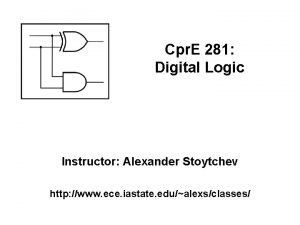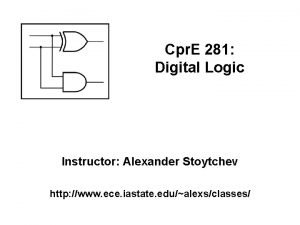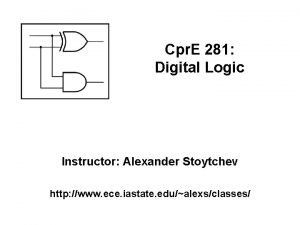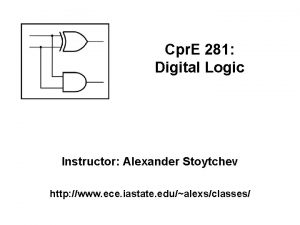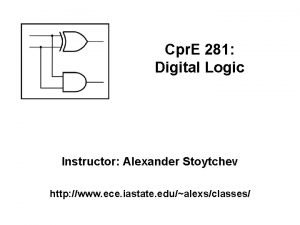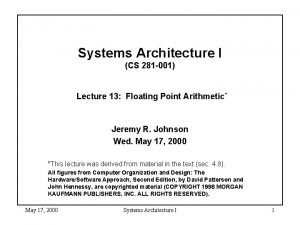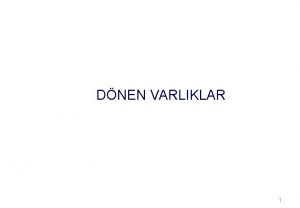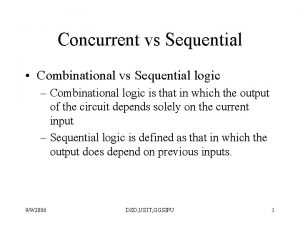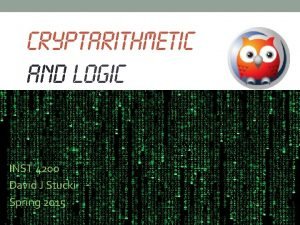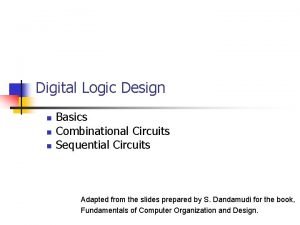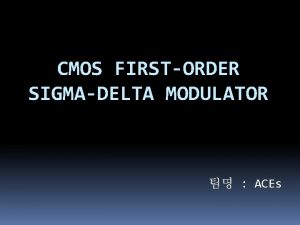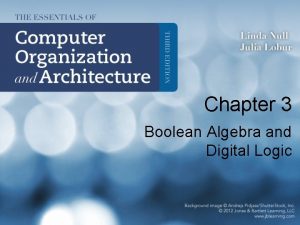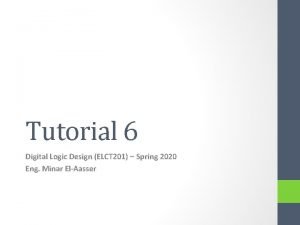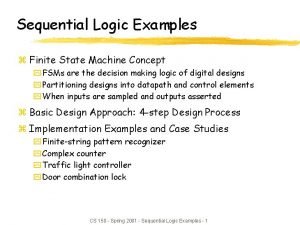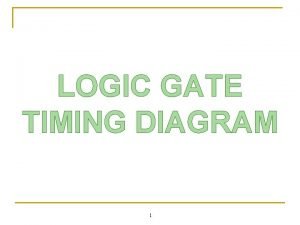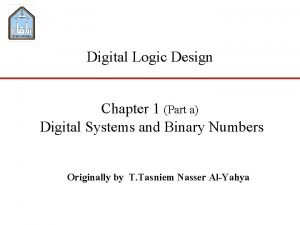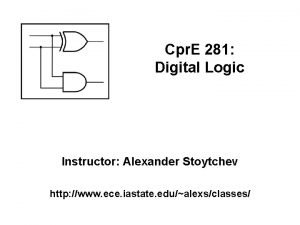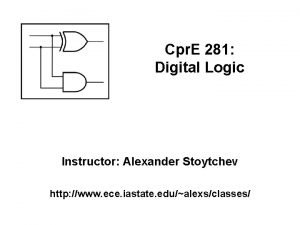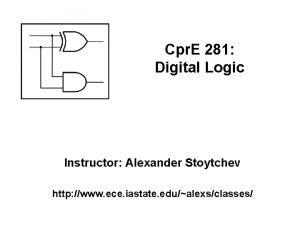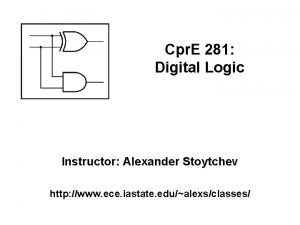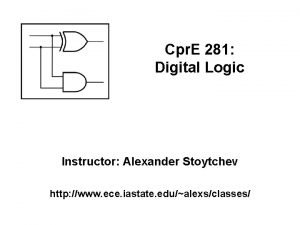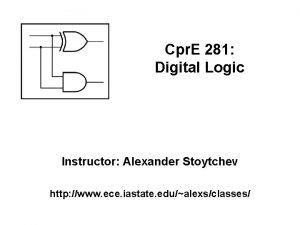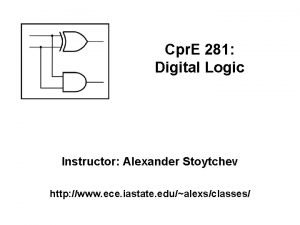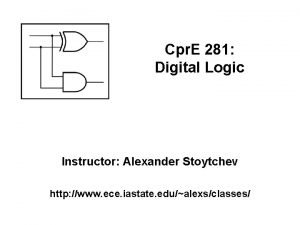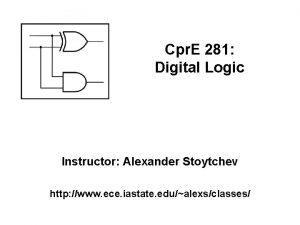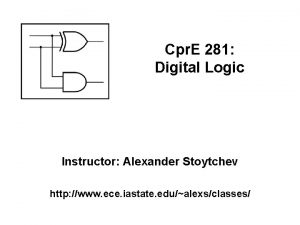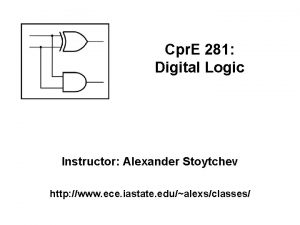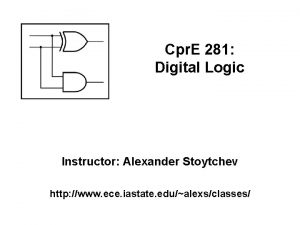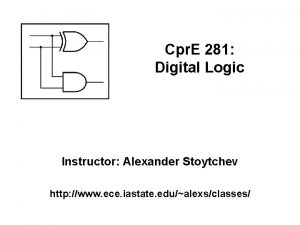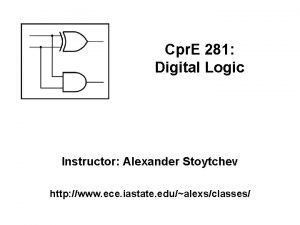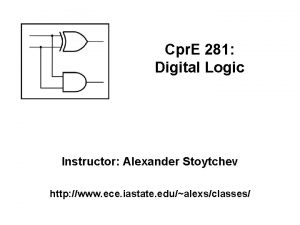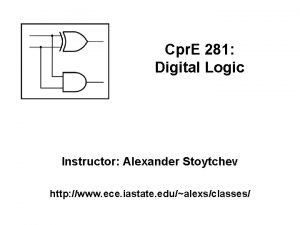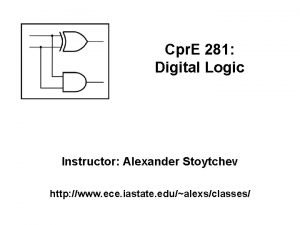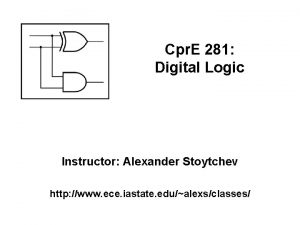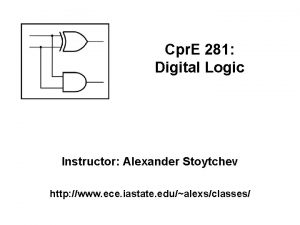Cpr E 281 Digital Logic Instructor Alexander Stoytchev




























- Slides: 28

Cpr. E 281: Digital Logic Instructor: Alexander Stoytchev http: //www. ece. iastate. edu/~alexs/classes/

FSM as an Arbiter Circuit Cpr. E 281: Digital Logic Iowa State University, Ames, IA Copyright © Alexander Stoytchev

Administrative Stuff • Homework 11 is out • It is due on Monday Nov 27 @ 4 pm

Administrative Stuff • Homework 12 is out • It is due on Monday Dec 4 @ 4 pm

Administrative Stuff • Final Project (7% of your grade). • By now you should have selected a project. • Read the instructions for the project carefully. • Also, posted on the class web page (Labs section). • This is your lab for the last two weeks. • This is due during your last lab (dead week).

Arbiter Circuit

Goal • Design a machine that controls access by several devices to a shared resource. • The resource can be used by only one device at a time. • Any changes can occur only on the positive edge of the clock signal. • Each device provides one input to the FSM, which is called a request. • The FSM produces one output for each device, which is called a grant.

Goal • The requests from the devices are prioritized. • If two requests are active at the same time, then only the device with the highest priority will be given access to the shared resource. • After a device is done with the shared resource, it must make its request signal equal to 0. • If there are no outstanding requests, then the FSM stays in an Idle state.

Conceptual Diagram Request 1 Grant 1 Device 1 Request 2 Arbiter Grant 2 Device 2 Request 3 Grant 3 Device 3 Shared resource

Conceptual Diagram Request 1 Grant 1 Device 1 Request 2 Arbiter Grant 2 Device 2 Shared resource Request 3 Grant 3 Device 3 Request (r) Grant (g) [ Figure 9. 20 from the textbook ]

State diagram for the arbiter 000 Reset Idle 0 xx 1 xx gnt 1 ¤ g 1 = 1 x 0 x 1 xx 01 x gnt 2 ¤ g 2 = 1 xx 0 x 1 x 001 gnt 3 ¤ g 3 = 1 xx 1 [ Figure 6. 72 from the textbook ]

State diagram for the arbiter 000 Reset Idle 0 xx Highest Priority Device 1 xx gnt 1 ¤ g 1 = 1 x 0 x 1 xx 01 x gnt 2 ¤ g 2 = 1 xx 0 x 1 x gnt 3 ¤ g 3 = 1 xx 1 001

State diagram for the arbiter 000 Reset Idle 0 xx Highest Priority Device 1 xx gnt 1 ¤ g 1 = 1 x 0 x 1 xx 01 x gnt 2 ¤ g 2 = 1 Lowest Priority Device xx 0 x 1 x gnt 3 ¤ g 3 = 1 xx 1 001

State diagram for the arbiter The three request bits 000 Reset r 1 r 2 r 3 Idle 0 xx 1 xx gnt 1 ¤ g 1 = 1 x 0 x 1 xx 01 x gnt 2 ¤ g 2 = 1 xx 0 x 1 x gnt 3 ¤ g 3 = 1 xx 1 001

State diagram for the arbiter Each device must release the resource after it is done using it 000 Reset Idle 0 xx 1 xx gnt 1 ¤ g 1 = 1 x 0 x 1 xx 01 x gnt 2 ¤ g 2 = 1 xx 0 x 1 x gnt 3 ¤ g 3 = 1 xx 1 001

Alternative style of state diagram for the arbiter r 1 r 2 r 3 Reset Idle r 1 gnt 1 ¤ g 1 = 1 r 2 r 1 r 2 gnt 2 ¤ g 2 = 1 r 3 r 2 r 1 r 2 r 3 gnt 3 ¤ g 3 = 1 r 3 [ Figure 6. 73 from the textbook ]

This design has one flaw: If device 1 and device 2 raise requests all the time, then device 3 will never get serviced.

This state diagram solves this problem

Let's look at a simpler example with only two devices that need to use the shared resource

State diagram for the simpler arbiter 00 Reset Idle 0 x 1 x gnt 1 ¤ g 1 = 1 x 0 1 x gnt 2 ¤ g 2 = 1 x 1 01

State diagram for the arbiter circuit

State Table

State-Assigned Table

Output Expressions

Next State Expressions

Circuit Diagram

Questions?

THE END
 Stoytchev 281
Stoytchev 281 Stoytchev 281
Stoytchev 281 Cpr e 281
Cpr e 281 Stoytchev
Stoytchev What is this
What is this Ipx-281
Ipx-281 Cs281 wordpress
Cs281 wordpress It is a circular or elliptical anticlinal structure
It is a circular or elliptical anticlinal structure Weathering types
Weathering types 281-284-0027
281-284-0027 Cs 281
Cs 281 Numeros romanos del 1 al 100
Numeros romanos del 1 al 100 Dönem ayırıcı hesaplar
Dönem ayırıcı hesaplar Dönem ayirici hesaplar 180 181 280 281 380 381
Dönem ayirici hesaplar 180 181 280 281 380 381 First order logic vs propositional logic
First order logic vs propositional logic First order logic vs propositional logic
First order logic vs propositional logic First order logic vs propositional logic
First order logic vs propositional logic Combinational logic vs sequential logic
Combinational logic vs sequential logic Tw
Tw Software development wbs
Software development wbs Majority circuit
Majority circuit Combinational logic sequential logic 차이
Combinational logic sequential logic 차이 Combinational logic sequential logic
Combinational logic sequential logic Digital logic design tutorial
Digital logic design tutorial Fsm digital logic
Fsm digital logic Timing diagram for logic gates
Timing diagram for logic gates Digital system design
Digital system design Plc mixer process control problem
Plc mixer process control problem Canonical form digital logic
Canonical form digital logic
